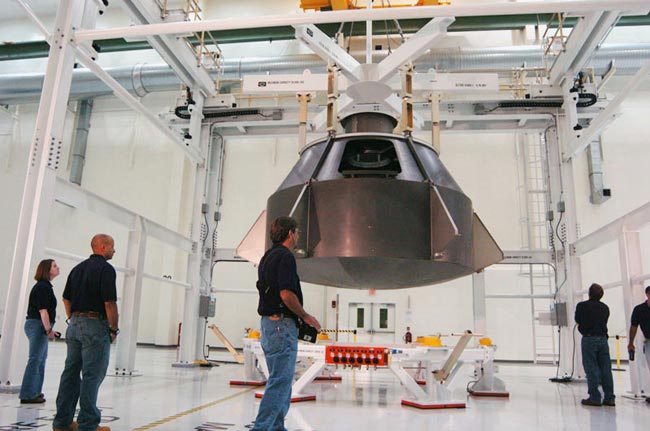First Orion Space Capsule Could Ride Huge Rocket In 2013

WASHINGTON?Lockheed Martin Space Systems is negotiating with United LaunchAlliance (ULA)to buy a Delta 4 Heavy launch for an unmanned test flight of the OrionCrewExploration Vehicle in 2013 even though NASA has not committed tofunding thedemonstration.
NASAofficials say the agency is still reviewing the cost and scope of theproposed unmannedOrion demonstration in the context of newly enactedlegislation that callsfor development by 2016 of a space capsule and heavy-lift rocketcapable oftaking astronauts beyond low Earth orbit.
ButJohnStevens, Lockheed Martin vice president of business development for theOrionprogram, said the Denver-based company simply doesn't have time to waitforNASA to finish its review.
"Ifwe'regoing to meet the 2016 flight date specified in the authorization bill,we haveto have a testflight in 2013," he told Space News Nov. 23, referring tolanguage inthe NASA Authorization Act of 2010 that U.S. President Barack Obamasigned intolaw Oct. 11. "So we've put our money down on this so we can reserve thelaunch slot for a 2013 test, because that's what's required to meet the2016date that Congress has set."
Orion'srocket deal
Stevensdeclined to say how much money Lockheed Martin put down to begin formalnegotiations with ULA, the Denver-based launch services providerjointly ownedby Lockheed Martin and Chicago-based Boeing Co. He said until NASAapprovesfunding for the demo, "any monies we put down as a deposit are at risk."
ULAspokesman Chris Chavez declined to comment on the flight test, but saidlaunchdeposits are equally split between Lockheed Martin and Boeing, whichmeans Lockheedwould forfeit half of its deposit monies if it is unable to reach acontractualagreement for the launch.
Breaking space news, the latest updates on rocket launches, skywatching events and more!
"Theforfeit of a non-refundable deposit would generate earnings dependinghow muchcost ULA has incurred working the activity up to the point offorfeit,"Chavezsaid in a Nov. 23 e-mail.
LockheedMartin, which beat Los Angeles-based Northrop Grumman Corp. and itsteammateBoeing in 2006 for a $3.9 billion contract to designand build Orion, expects to complete the unmanned testflight, even thoughthe Orion's future has been in question since February when Obamaproposedcanceling the six-person capsule along with the rest of NASA'smoon-boundConstellation program. A
Althoughtheagency still plans to kill Constellation's Ares family of rocketspendingcongressional approval in a 2011 spending bill, Orion won a reprieve inAprilwhen Obama announced plans to use it as a crew lifeboat for theInternationalSpace Station.
Obama'slifeboat proposal, widely viewed as more of a politicalconcession than atechnical necessity, encountered resistance within NASA, industry andultimately Congress.
MultipurposeOrion capsules
TheNASAAuthorization Act the president finally signed into law in Octoberended upcalling for development of a multipurpose crew vehicle ? MPCV for short? readyby 2016 to carry astronautson deep space missions, not just short jaunts back from thespace station.
Althoughthe law does not specify Orion as the MPCV it does direct NASA toleverageOrion hardware and designs when building it.
Additionally,draft 2011 spending legislation the Senate Appropriations Committeeapproved inJuly included $1.1 billion to continue work on Orion, the same amountauthorizedfor the MPCV. The NASA spending bill has yet to be approved by the fullSenate,but elements of it could be worked into a broader spending package for2011 inthe coming weeks.
NASAofficials, meanwhile, say the agency is still determining how toproceed withOrion and is developing a plan to implement the MPCV requirementsoutlined inthe 2010 NASA Authorization Act. [Video:NASA's Orion Spacecraft Coming Together]
"Muchof the [work] related to MPCV can continue under the existingcontracts, but,as appropriate, NASA will be conducting acquisition strategy meetingstodetermine if other steps are needed to meet the MPCV scope,requirements andmajor test objectives,"NASA spokesman Michael Braukus wrote in a Nov.19e-mail, adding that the 2013 flight test of Orion is still under reviewtodetermine if sufficient funding is available.
"Atthis juncture, NASA does not anticipate specifying a particular vehicleto thecontractor; the Agency will focus on meeting the major testobjectives,"hewrote.
DespiteLockheed Martin's unorthodox approach to acquiring a launch vehicle forthe2013 test, Stevens said the move squares with Obama's new vision forNASA, whichseeks to foster a market for commercially built rockets and hardwarethrough acombination of public and private investment.
"That'spart of the new paradigm ? we're supposed to have skin in the game,"hesaid. "We are running at risk, to a limited extent, hopefully, but thenagain, that's what doing this in a quasi-commercial fashion means."
Testingfor a deep space mission
StevenssaidOrion's original test regime included early flight tests of anun-crewedcapsule to low Earth orbit atop Ares I. With NASA's plan to discontinuetheAres family of rockets in favor of relying on privately developedtransportation services, Orion's scope and test objectives havechanged.
"Intheoriginal plan [the test flight] was a predecessor to going to station,"hesaid. "Now we're doing a more complete test of the vehicle, in somesense,than we were before."
Stevenssaidthe 2013 test flight Lockheed is planning would launch Orion into ahighlyelliptical orbit with a 17,000 kilometer apogee, setting up the capsuletore-enter Earth's atmosphere at speeds it would encounter returning froma deepspace mission.
"Thenotion is that you put it in a highly elliptical orbit so it has ahigherre-entry speed than a low Earth orbit," Stevens said. "As you comeback down from the apogee of that orbit, you accelerate the vehicle sothat wecan achieve actual re-entry speeds that are the same as those fromlunarorbits."
Relativetoprevious test flights planned under the Constellation program, Stevenssaid thelunarvariant of Orion that would be used to conduct the 2013 testwould shedsome subsystems for flight atop the Delta 4 heavy, which is capable ofdelivering about 25 metric tons of payload to low Earth orbit.
Forexample,while the capsule would fly with a modified version of its Launch AbortSystemaboard, only the jettison motors designed to pull the system away fromthecapsule would be active, Stevens said.
"Becauseit's not a manned mission you don't have to have the Launch AbortSystem butfor aerodynamic purposes, so we want to do an aerodynamic match,"Stevenssaid, adding that the spacecraft's solar arrays also will not fly onthemission.
BigNASArockets on tap
StevenssaidLockheed Martin is not planning to book Delta 4 Heavy for any Orionmissionsbeyond the unmanned 2013 test flight, mainly because NASA is expectedto beginbuilding and testing a heavy-liftlaunch vehicle as directed in the NASA authorization act.
"Weanticipate there would be some test flights of that prior to 2016 andthat wewould sync up with those test flights," he said. "That would be apreferred option rather than using [a Delta 4 or Atlas 5] if the[heavy-liftvehicle] is available,"he said.
WhileLockheed Martin is content to see Orion launch on a new NASA-ownedheavy-liftrocket, ULA has made no secret of its ambitions to launch crewedvehicles,whether for NASA or commercial providers.
Forexample,ULA Chief Executive Officer Michael Gass, for example pitched the Delta4 Heavyfor Orion in 2009 to the Augustine Committee, the White House-appointedpaneltasked with reviewing NASA's manned spaceflight plans.
InOctober,ULA's vice president of business development, George Sowers, told acommercialspaceflight symposium the best way to get Orion flying early is tolaunch itatop a Delta 4 Heavy.
"Rightnow the Delta 4 Heavy is the only rocket in the U.S. fleet with therequiredlift capability," he said in a speech at the International SymposiumforPersonal and Commercial Spaceflight in Las Cruces, N.M. Oct. 20. "Thiswill get you an un-crewed demo as early as 2013 and crewed flights asearly as2014 or 2015."
Sowerssaidonce Orion is flying, all that is needed to facilitate missions beyondlowEarth orbit is the ability to refuel the Centaur upper-stage in space."Onerefueling means the capability to go to an Earth-Moon Lagrange point,or to doan Apollo 8-style lunar fly-by,"he said.
NASA'scommercial spaceship push
ULAwas oneof five companies NASA chose in February to participate in the firstround ofCommercial Crew Development projects intended to support Obama'scommercialcrew initiatives. The company has used its $6.7 million award to workon anEmergency Detection System needed to human rate its Atlas 5 and Delta 4rockets.
Gasstoldthe Augustine Committee in 2009 ULA would need four-and-a-half years tohuman-rate the Delta 4 Heavy at a one-time cost of $500 million plus$300million per launch.
However,a2009 study by Los Angeles-based Aerospace Corp. that examined cost andscheduleimplications associated with human-rating the Delta 4 Heavy launcherfound theprocess could take between five-and-a-half and seven years to complete.
Asfar asDelta 4 is concerned, Lockheed Martin said its focusNASA's Most Memorable Missions for now is on theproposed2013 Orion flight test.
"Itwould be premature for me to make any statement about whether or not wewouldtry to launch humans on an Orion on a Delta 4," he said.
- Video:NASA's Orion Spacecraft Coming Together
- MissionProposed to Send Astronauts to the Moon's Far Side
- NASA's Most Memorable Missions
Thisarticle was provided by Space News,dedicatedto covering all aspects of the space industry
Amy Svitak is a writer for Space Intel Report, covering the global space industry. Her older work can also be found in Aviation Week & Space Technology, where she covered European space and defense news, as well as in Space News, where her articles tracked the development of regulations on the up-and-coming commercial space sector, among other topics.
